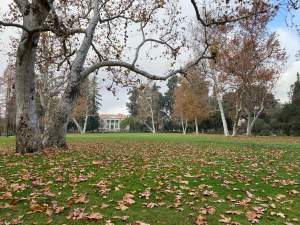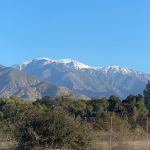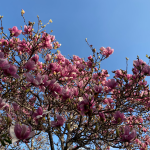By Emma Grace Howlett ‘25
One of my earliest memories as a child is of walking through a magenta archway of blooming foxgloves. Leaning my head back to look up at the tall ethereal flowers swaying in the gentle breeze, I dared to stick my finger into one of the conical flowers.
Today, I still like to investigate the abundance of flora around me. For as long as I can remember my Dad had a garden bursting with flowers, and a vegetable patch we would sow every spring. Later in life, when my Dad and I started going on backpacking trips together, he would point out the different trees and teach me their names. We would come up with fun sayings to remember them, like “Puzzle-piece Ponderosa” or “Dark Douglas” or “Stringy Cedar.” We would stroll through undergrowth of spirea, fern, devil’s club, and vine maple while hemlocks and firs towered above us. Somehow, knowing the names of the plants in my environment made spending time in nature more meaningful to me. Rarely do people become friends without knowing each other’s names, and it is the same with plants. Once I know a plant’s name, I am happy to call it my friend.
I have lived in the Seattle area my whole life, and have come to have a close relationship with my friends the evergreens. Moving to Claremont meant leaving my familiar floral friends behind! Here I met strangers such as the palm tree, the redwood, the eucalyptus, the sycamore, the elm, and the coast live oak. I was struck by the vast difference between the plants of Southern California and those of my home, the Pacific Northwest. I was mesmerized by the white, flaky bark of the eucalyptus, and awed by the thick, wandering branches of the oaks.

 While catching up with these new friends, after returning from winter break, I noticed a rather curious phenomenon. While reading a book on Marston Quad beneath the towering sycamores, I heard the rustling of falling leaves. All around me, spread like ripples in a pond, were thousands of fallen leaves. Filled with a childlike wonder, I immediately got up and began to walk, eager to hear the crunch of dried leaves underfoot. The sound was deliciously crackly. I continued to walk past Big Bridges, on my way to Frary Dining Hall. In the distance loomed the San Gabriel Mountains, topped with a glistening, silvery layer of snow. As Frary appeared to my right, I stopped in my tracks: before me stood a tulip magnolia in the full glory of its bloom.
While catching up with these new friends, after returning from winter break, I noticed a rather curious phenomenon. While reading a book on Marston Quad beneath the towering sycamores, I heard the rustling of falling leaves. All around me, spread like ripples in a pond, were thousands of fallen leaves. Filled with a childlike wonder, I immediately got up and began to walk, eager to hear the crunch of dried leaves underfoot. The sound was deliciously crackly. I continued to walk past Big Bridges, on my way to Frary Dining Hall. In the distance loomed the San Gabriel Mountains, topped with a glistening, silvery layer of snow. As Frary appeared to my right, I stopped in my tracks: before me stood a tulip magnolia in the full glory of its bloom.
 The tulip-shaped flowers arched high against the perfect blue sky, their magenta petals swaying in the breeze just like the foxgloves in my Dad’s garden. Their bright velvety smell wafted down to me like a greeting.
The tulip-shaped flowers arched high against the perfect blue sky, their magenta petals swaying in the breeze just like the foxgloves in my Dad’s garden. Their bright velvety smell wafted down to me like a greeting.
I paused for a moment in wonder and confusion. The campus was littered with fallen leaves, the mountains had snow, and yet here was a tulip magnolia wearing the crown of its new bloom.
Being from Seattle, I am forever grateful for the Edenic weather of Claremont. Yet this remarkable mix of autumn, winter, and spring is something I could never have anticipated. In January, the Siberian irises wear royal purple while dying leaves fall about them. These particular irises, flowering on Marston Quad, have been in bloom since October. I admire such a steadfast outpouring of energy and beauty.
Next time you take a walk, say hello to the flora and take a moment to notice the joyous intermingling of fall, winter, and spring playing out across campus. You might just make a friend.
